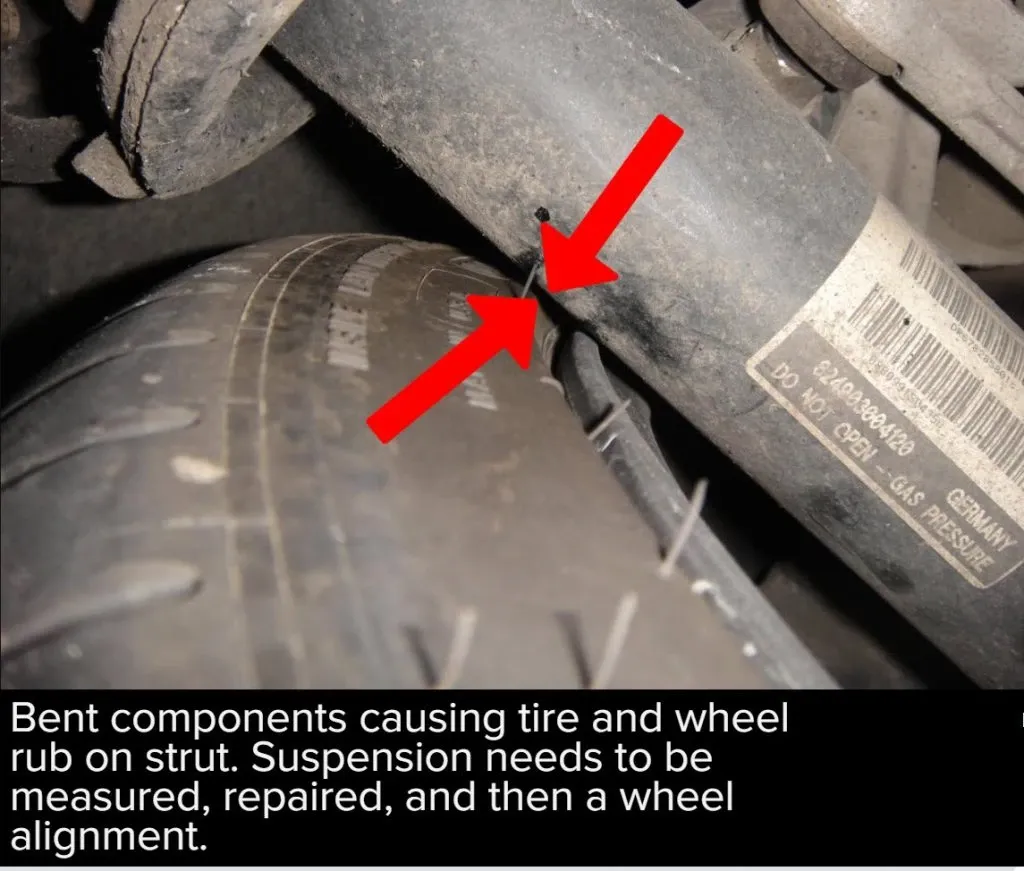

The main sign that your suspension components are bent is a comfort loss, meaning a sturdy ride with more shaking/vibration. This is because the suspension system depends on a specific structure arrangement, and if something in it is misaligned, the system won't work properly.
Suspension components like shock absorbers, control arms, springs, etc., help wheels absorb impact while driving. But, if any of these components start malfunctioning, wheels can easily misalign and cause even more damage to the system.
- Key function: Suspension components have the ultimate goal of absorbing impact from the road in a way that creates a smoother ride, protecting the wheels, providing stability, and assisting with steering.
The misalignment that bent suspension components create can have several symptoms.
- Safety: A vehicle has several dangers if its suspension components are faulty. For example, if the suspension gets bent, the wheels might misalign, making the vehicle pull to one side. Additionally, wheels might wear faster and steering can fail, posing traffic risks.

Burning rubber smell
A common sign of bent suspension components is a burning rubber smell. The smell appears because of friction, possibly from the wheels or rubber seals on suspension components. The friction happens because the misalignment affects the system, making car parts stretch out of position and rub against something rubber.
Since the suspension system is next to the wheels, the most common burning rubber smell comes from the tires. Typically, a bent suspension component has a high chance of sticking out and rubbing against the tires. So, when the car is driving, the tires suffer friction from contacting the component, increasing heat and burning.
Forced steering
A bent suspension component might push the front and rear wheels, misaligning them, and causing the vehicle's steering to be tougher. In this case, the misaligned wheels might pull the vehicle to one side, making the steering wheel heavier to control.
Misaligned wheels can also cause extra wear on the tires, and overstress steering and brake components, causing further damage and expenses.
Alternatively, a bent control arm, which is part of the suspension system, can also make steering tougher since it's directly related to the steering wheel movement.
Other common signs
Here are other common signs that your vehicle’s suspension components are bent:
- Vehicle leaning to one side
- Uneven tire wear
- Clunking noises
- Fluid leaks
- Changes in height
Possible fixes
- Test suspension components to diagnose: It's important to do an inspection of the entire suspension system to test out every component and check for safety risks and progressive damage. Ask a professional to verify your suspension system, compare camber readings, and plan the best fix.
- Control arm replacement: The control arm helps the wheels to keep aligned, ensuring they can move up and down properly. A broken control arm results in a bad steering axis inclination, harming the vehicle's steering, camber angles, and comfort.
- Strut assembly replacement: The strut assembly has springs and shock absorbers that help your vehicle vibrate less while increasing comfort. A faulty one makes the vehicle tougher to control, resulting in poor handling.
- Ball joint replacement: Ball joints are vital in allowing movement to the vehicle's wheels and suspension while supporting all the weight. Replacing faulty ball joints is needed to ensure proper steering, handling, and alignment.
- Tie rod replacement: The tie rod is a vital steering component that transfers the steering wheel movement to the vehicle's wheels. So, a faulty steering rack results in steering difficulties.
Frequently Asked Questions
Can suspension damage be fixed?
Suspension damage can sometimes be fixed, but it depends on the severity. Minor bending may be repairable, but major bends or cracks usually require replacing the component. Worn parts like bushings, the strut tower, the lower control arm, or shocks are typically replaced, not repaired. It's always best to have a mechanic diagnose the damage to ensure a safe and proper repair.
What does a bent strut cause?
A bent strut can significantly impact your vehicle's performance and safety. It disrupts the wheel alignment, leading to uneven tire wear. You might notice the car pulling consistently towards one side while driving. Additionally, the ride quality will be compromised, feeling shaky and uncomfortable. Bad steering will also affect directional stability, requiring increased effort or becoming unresponsive. If you suspect a bent strut, it's crucial to have a qualified mechanic in an alignment shop inspect your vehicle for a proper diagnosis and repair.
Can you still drive with a bent strut?
Driving with a bent strut isn't ideal and shouldn't be done for extended periods. It can cause uneven tire wear, pulling towards one side, bad angle side to side, and a shaky ride. More importantly, it can negatively impact your steering and make the car handle unpredictably, potentially compromising safety. If you must drive with a suspected bent strut, check your vehicle's different camber readings to see how severe the misalignment can be, and drive slowly and with extra caution until you can get it replaced by a mechanic.






